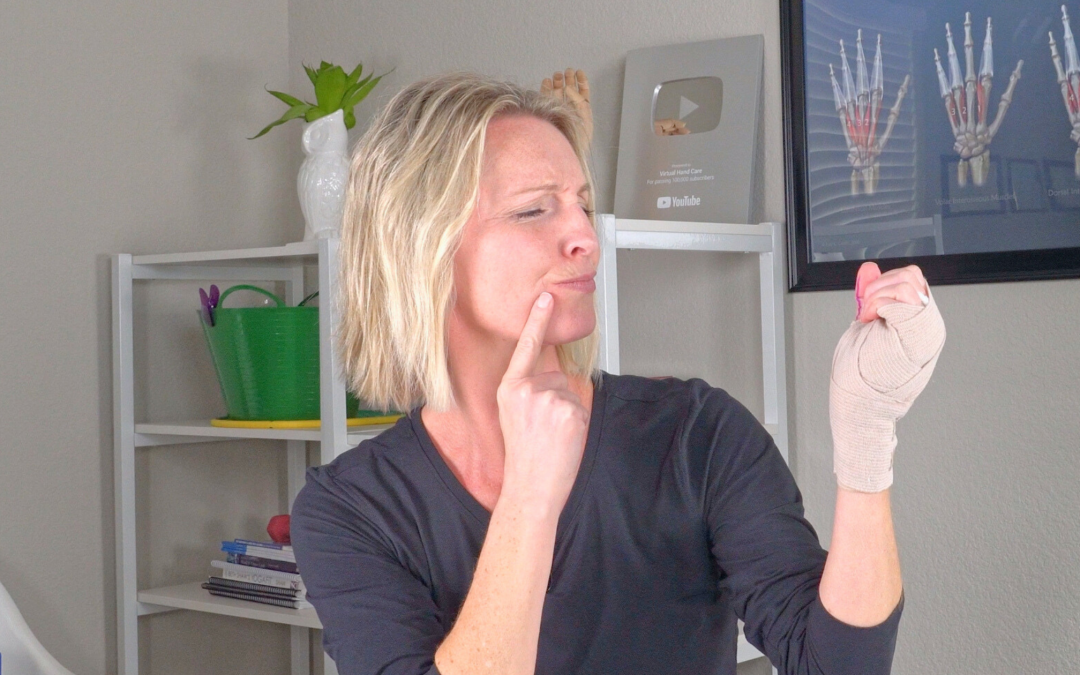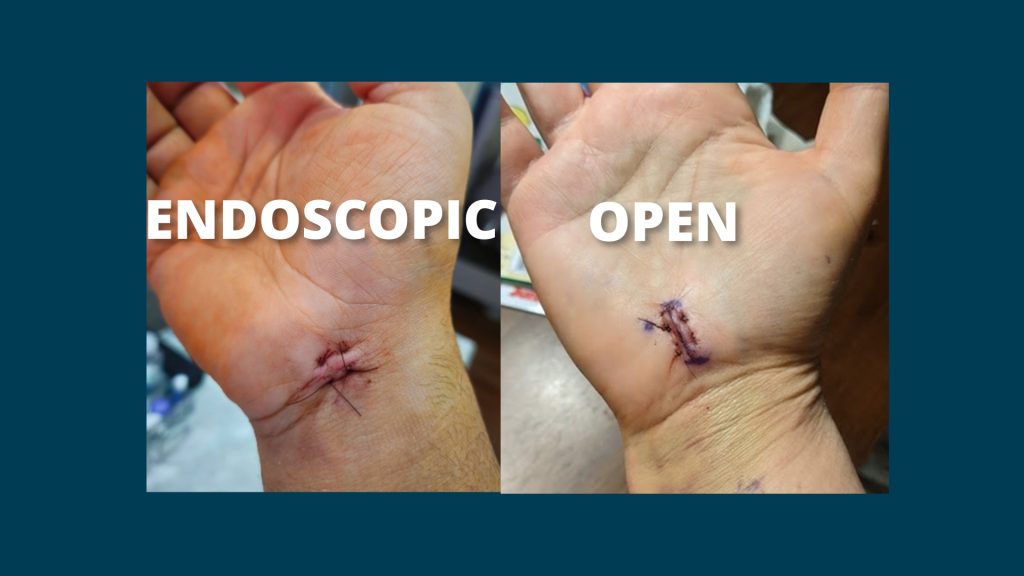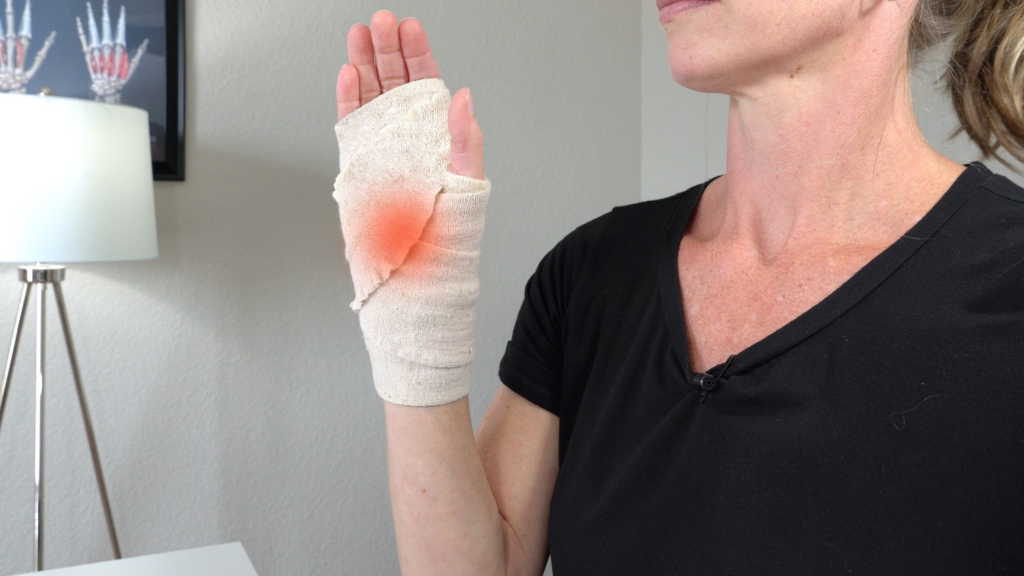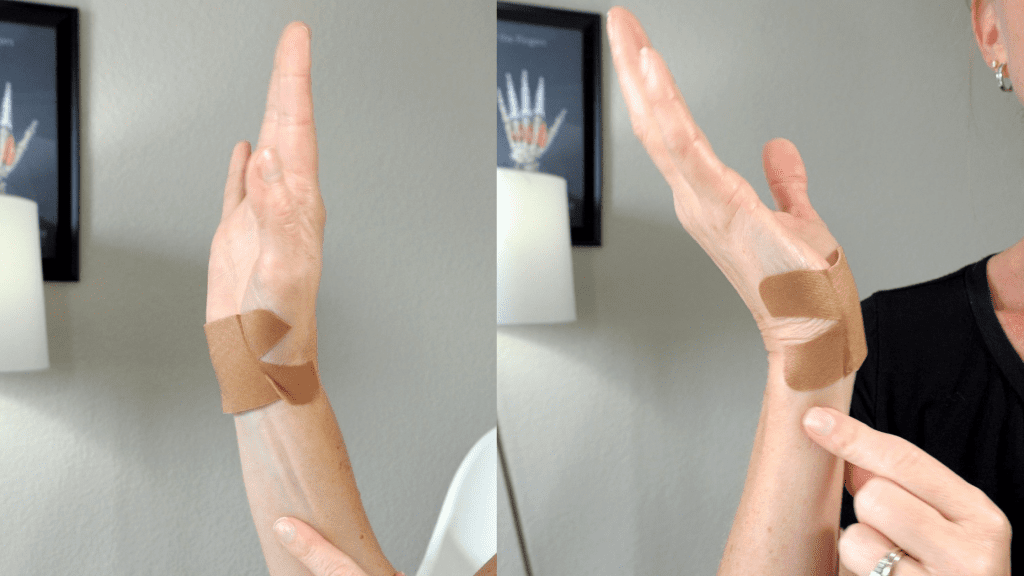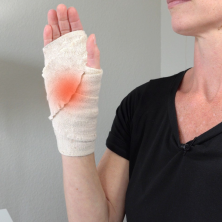What should you expect 1 week after your carpal tunnel surgery? If you’re navigating this early stage, you might have questions about what’s normal, what’s not, and what tips can help you stay on the right track to full recovery.
This blog post will hopefully ease your concerns and answer your questions. Because I’m going to share hot topics such as dressings and incision care; pain and swelling; movement and function; and understanding your limits 1 week after carpal tunnel surgery.
Real quick, if you haven’t had surgery yet and want to better prepare yourself, then learn how to prepare for your upcoming carpal tunnel surgery here.
But if you had surgery, remember every person heals differently. Not to mention, every surgery and surgeon is different.
That’s why it’s necessary to follow your doctor’s post operative instructions.
With all that said, let’s dive into what to expect 1 week after your carpal tunnel surgery or you can watch my YouTube video here.
Dressings and Incision Care
As your incision heals, it’s necessary to maintain a clean environment for your incision to prevent infection. Your doctor or post operative nurse should have given you instructions after your surgery on how to do that. Make sure you follow those guidelines.
When you have carpal tunnel surgery, it’s performed either endoscopically or open.
If you had an endoscopic carpal tunnel release more than likely you still have 1 long stitch, or 1-2 small stitches, right at the top of your wrist.
Or if you had an open carpal tunnel release you may have several smaller stitches at the base of your palm.
At 1 week post op, some of you may still have your surgical dressing on, so you may not even know what your incision looks like at this point.
Some doctors allow you to remove your own dressings after just a few days. Another common option is to go to hand therapy where a hand therapist will remove them for you.
Unfortunately, dressings and incision care vary greatly amongst doctors.
If you’re in the first group, and still have your surgical dressings on, then there’s not much you can do at this point.
Except to be patient. More than likely you have an appointment very soon to get your dressings removed.
But if you are having a lot of incision pain, or really struggling with your dressings, then you may want to give your doctor’s office a call. Your doctor may let you remove your dressings at this point or come in for an earlier appointment.
For those of you with minimal dressings, you likely get to care for your own incision and stitches.
Stitches are typically removed around 8-10 days, give or take. It can be longer for diabetics or if your incision is not healing.
Even though stitch removal is right around the corner, it’s important to continue keeping your incision clean.
The general rule for incision care is to avoid applying a lot of soaps, lotions, or ointments, at least in my experience.
Some doctor’s will allow a very thin layer of vaseline to prevent your incision from drying out. But some doctors will not want you to apply anything.
While others actually want you to use a neosporin or polysporin. It can be confusing what to do!
In my experience, applying too much of anything can cause irritation or maceration. Basically your incision gets too moist.
The best environment for your incision to heal is a balance of not too dry but also not too moist.
Either way, your incision is still healing, so avoid creams or fragrances, cleaning with alcohol, and avoid soaking your hand under water for long periods of time.
Covering your incision is still a good idea though, especially if you are going out for errands.
For that, a larger bandaid or Tegaderm film can do the job. Even a small compression sleeve over your hand can be a nice additional barrier to dirt and germs.
Pain and Swelling
Pain
By now your pain and swelling has likely improved A LOT compared to right after surgery.
In my experience, most people at this point do not have a lot of pain but describe more of an achy feeling. This is located around the thenar muscles of your thumb.
Typically wrist movements usually cause a little more discomfort with the endoscopic release. This is because you’re pulling on the incision at your wrist.
With the open carpal tunnel release, you may feel more discomfort moving your thumb due to the pulling on the incision at the base of your thumb.
While everybody has their own unique tolerance to pain; carpal tunnel surgery tends to cause mild discomfort.
Extreme postoperative pain is less common, unless you developed a complication such as an infection, or if you had additional procedures performed.
Either way, it’s very important to communicate with your surgeon if you are having high levels of pain that’s preventing you from sleeping or wanting to move your fingers.
Swelling
Since your pain is typically minimal 1 week after carpal tunnel surgery, your swelling is minimal too!
Now that doesn’t necessarily mean you can wear a watch or ring yet. But the swelling in your fingers and hand should be mild.
It’s pretty normal at this point to notice fluctuations in your hand swelling. Swelling can be triggered by certain activities such as overusing your hand or enjoying too much salty popcorn the night before.
Rest assured, mild swelling may occur in your hand for several weeks.
On the flip side, excessive or severe swelling, especially if it is accompanied with redness and pain, is not common 1 week after carpal tunnel surgery.
This could be a sign of an infection and should be brought to your doctor’s attention right away.
Basically, a little discomfort and mild swelling is still expected. It’s only been a week!
Actually, moving and using your hand for light activities can help your pain and swelling. That leads me to:
Exercise, Movement, and Function
Exercise
This is where your focus should be 1 week after carpal tunnel surgery.
Ideally your finger, thumb, and wrist range of motion should be normal or at least functional.
At this point, you should be able to make a gentle fist, move your thumb to the tip of each finger, as well as bend your wrist back and forth.
Now you may not be able to squeeze into a tight fist or move your thumb all the way across your palm without discomfort.
But the quicker you can recover your normal motion, the sooner you’ll be able to do most daily activities at this point.
You should be able to pick up a cup, carry your phone, or maybe do a little typing.
Plus you may not have the endurance to do all that for too long.
And it’s not uncommon for your fingers to feel weak- or even slightly numb– because your nerve is still healing.
So make sure you’re doing finger, thumb, and wrist active range of motion exercises a few times a day because that can help get your endurance back faster.
If you are looking for carpal tunnel specific exercises you can do, then check out my Best Exercises After Carpal Tunnel Surgery video here.
That brings me to function.
Function
As I mentioned, you’ll likely have normal, or close to normal motion.
So there will be a lot of light activities you will be able to do like folding laundry, getting dressed, and feeding yourself.
But stay out of dirty dish water since you still have your stitches in.
As you start using your hand more you’ll likely notice you have NO strength or endurance.
And that’s totally normal right now.
Even though you may be able to hold light things, you may not be able to open a bottle or a jar, hold a blow dryer for too long, or open a sticky lid of toothpaste.
This is largely due to decreased finger and thumb strength but also because your sensation hasn’t returned all the way.
And you may notice your hand get tired and achy, if you try to do too much for too long.
So you may not be able to spend a lot of time on food preparation AND cooking because by the time you have to feed yourself your hand may FEEL EXHAUSTED.
The good news is this will improve over these next few weeks as you use your hand more and more. And as you continue to heal.
At this stage, it’s okay to ask for help from others.
Or if you don’t have anyone then using a gadget such as an electric can opener or having a few meals delivered to you can be a huge help.
Plus it will prevent you from overstraining your hand.
Activities you should just not even try at this point, if you can help it, are strenuous activities like shoveling or using tools that vibrate. Avoid heavy lifting, or anything that requires you to put a lot of pressure into your palm or activities that require you to overstretch your healing nerve.
You’ll likely have to wait to get back to doing yoga or pushups. Plus it’s not really the time to start any new renovation projects.
If you have more specific questions or you’re unsure of what you can or can’t do, then always ask your surgeon.
Understanding Your Limits
At this stage of recovery, there are usually 2 types of people.
The 1st group feels great. You have minimal to no pain and do more than your should.
I get it! You can finally sleep at night and use your hand normally.
If you fall into this category, patience is key.
Despite the temptation to dive back into normal life you can easily overdo it and set yourself backwards causing more pain, more swelling, and more scarring.
Therefore, continue to protect your incision, and avoid heavy lifting or gripping at this point.
On the flip side, the 2nd group tends to be more cautious, or maybe even afraid to move due to pain. If you relate, you may fear undoing something inside your hand and ruining the surgery.
If you fall into this category, your joints can stiffen up quickly. This not only causes pain, but your tendons could be in the early stages of scarring down.
A carpal tunnel release is just that… a release!
Not a repair.
Sure your doctor repairs your skin to close the incision but there’s nothing inside your hand that you can undo.
Unless your doctor explicitly advised you not to move, and in that case you’d probably have a large, protective splint or cast on your hand.
Which is not common with a carpal tunnel release.
So I encourage you to work on your hand and wrist motion. Ask your doctor or therapist for some gentle exercises.
You’ll feel better and it will actually help with decreasing your pain and swelling. Plus get you closer to using your hand for activities you love.
Conclusion
As you continue to navigate through your carpal tunnel recovery remember to follow your surgeon’s instructions diligently.
Continue to keep your incision clean, you will be stitch free very soon!
Make sure you are rehabbing yourself with active finger, thumb, and wrist exercises and with light daily activities.
But remember- listen to your body when your hand gets tired. Stop what you are doing and rest.
Healing takes time!

